Nickel
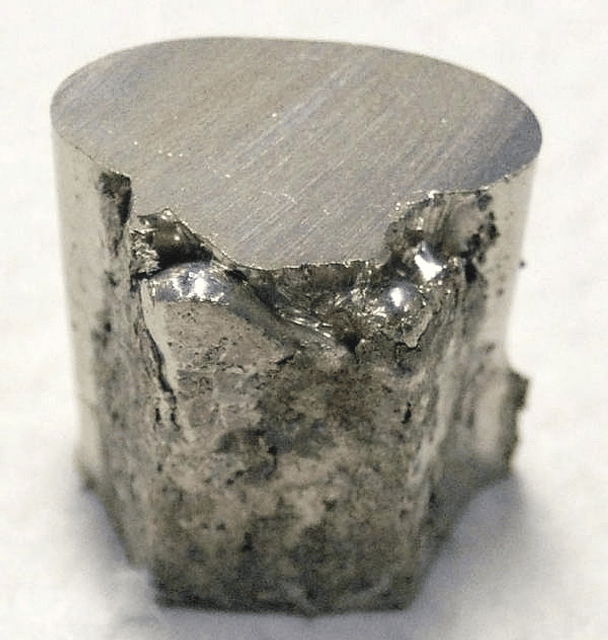
Nickel

| Nickel | |
|---|---|
| Appearance | lustrous, metallic, and silver with a gold tinge |
| Standard atomic weight | [1] |
| Nickel in theperiodic table | |
| 28 | |
| Group | |
| Period | period 4 |
| Block | d-block |
| Element category | Transition metal |
| Electron configuration | or |
| 2, 8, 16, 2or2, 8, 17, 1 | |
| Physical properties | |
| Phase | solid |
| Melting point | 1728K(1455 °C, 2651 °F) |
| Boiling point | 3003 K (2730 °C, 4946 °F) |
| Density | 8.908 g/cm |
| 7.81 g/cm | |
| Heat of fusion | 17.48kJ/mol |
| Heat of vaporization | 379 kJ/mol |
| Molar heat capacity | 26.07 J/(mol·K) |
| Vapor pressure | |
| Atomic properties | |
| Oxidation states | −2, −1, +1,[2], +3, +4[3](a mildlybasicoxide) |
| Electronegativity | Pauling scale: 1.91 |
| Ionization energies | |
| Atomic radius | empirical: 124pm |
| Covalent radius | 124±4 pm |
| Van der Waals radius | 163 pm |
| Other properties | |
| Natural occurrence | primordial |
| Crystal structure | face-centered cubic(fcc) |
| Speed of sound | 4900 m/s (at) |
| Thermal expansion | 13.4 µm/(m·K) (at 25 °C) |
| Thermal conductivity | 90.9 W/(m·K) |
| Electrical resistivity | 69.3 nΩ·m (at 20 °C) |
| Magnetic ordering | ferromagnetic |
| Young's modulus | 200 GPa |
| Shear modulus | 76 GPa |
| Bulk modulus | 180 GPa |
| Poisson ratio | 0.31 |
| Mohs hardness | 4.0 |
| Vickers hardness | 638 MPa |
| Brinell hardness | 667–1600 MPa |
| CAS Number | 7440-02-0 |
| History | |
| Discoveryand first isolation | Axel Fredrik Cronstedt(1751) |
| Mainisotopes of nickel | |
| Hazards | |
| GHS pictograms | |
| GHS signal word | Danger |
| ,,, | |
| ,,,[undefined] | |
| NFPA 704 | |
Nickel is a chemical element with the symbol Ni and atomic number 28. It is a silvery-white lustrous metal with a slight golden tinge. Nickel belongs to the transition metals and is hard and ductile. Pure nickel, powdered to maximize the reactive surface area, shows a significant chemical activity, but larger pieces are slow to react with air under standard conditions because an oxide layer forms on the surface and prevents further corrosion (passivation). Even so, pure native nickel is found in Earth's crust only in tiny amounts, usually in ultramafic rocks,[6][7] and in the interiors of larger nickel–iron meteorites that were not exposed to oxygen when outside Earth's atmosphere.
Use of nickel (as a natural meteoric nickel–iron alloy) has been traced as far back as 3500 BCE. Nickel was first isolated and classified as a chemical element in 1751 by Axel Fredrik Cronstedt, who initially mistook the ore for a copper mineral, in the cobalt mines of Los, Hälsingland, Sweden. The element's name comes from a mischievous sprite of German miner mythology, Nickel (similar to Old Nick), who personified the fact that copper-nickel ores resisted refinement into copper. An economically important source of nickel is the iron ore limonite, which often contains 1–2% nickel. Nickel's other important ore minerals include pentlandite and a mixture of Ni-rich natural silicates known as garnierite. Major production sites include the Sudbury region in Canada (which is thought to be of meteoric origin), New Caledonia in the Pacific, and Norilsk in Russia.
Nickel is slowly oxidized by air at room temperature and is considered corrosion-resistant. Historically, it has been used for plating iron and brass, coating chemistry equipment, and manufacturing certain alloys that retain a high silvery polish, such as German silver. About 9% of world nickel production is still used for corrosion-resistant nickel plating. Nickel-plated objects sometimes provoke nickel allergy. Nickel has been widely used in coins, though its rising price has led to some replacement with cheaper metals in recent years.
Nickel is one of four elements (the others are iron, cobalt, and gadolinium)[9] that are ferromagnetic at approximately room temperature. Alnico permanent magnets based partly on nickel are of intermediate strength between iron-based permanent magnets and rare-earth magnets. The metal is valuable in modern times chiefly in alloys; about 68% of world production is used in stainless steel. A further 10% is used for nickel-based and copper-based alloys, 7% for alloy steels, 3% in foundries, 9% in plating and 4% in other applications, including the fast-growing battery sector.[10] As a compound, nickel has a number of niche chemical manufacturing uses, such as a catalyst for hydrogenation, cathodes for batteries, pigments and metal surface treatments.[11] Nickel is an essential nutrient for some microorganisms and plants that have enzymes with nickel as an active site.
| Nickel | |
|---|---|
| Appearance | lustrous, metallic, and silver with a gold tinge |
| Standard atomic weight | [1] |
| Nickel in theperiodic table | |
| 28 | |
| Group | |
| Period | period 4 |
| Block | d-block |
| Element category | Transition metal |
| Electron configuration | or |
| 2, 8, 16, 2or2, 8, 17, 1 | |
| Physical properties | |
| Phase | solid |
| Melting point | 1728K(1455 °C, 2651 °F) |
| Boiling point | 3003 K (2730 °C, 4946 °F) |
| Density | 8.908 g/cm |
| 7.81 g/cm | |
| Heat of fusion | 17.48kJ/mol |
| Heat of vaporization | 379 kJ/mol |
| Molar heat capacity | 26.07 J/(mol·K) |
| Vapor pressure | |
| Atomic properties | |
| Oxidation states | −2, −1, +1,[2], +3, +4[3](a mildlybasicoxide) |
| Electronegativity | Pauling scale: 1.91 |
| Ionization energies | |
| Atomic radius | empirical: 124pm |
| Covalent radius | 124±4 pm |
| Van der Waals radius | 163 pm |
| Other properties | |
| Natural occurrence | primordial |
| Crystal structure | face-centered cubic(fcc) |
| Speed of sound | 4900 m/s (at) |
| Thermal expansion | 13.4 µm/(m·K) (at 25 °C) |
| Thermal conductivity | 90.9 W/(m·K) |
| Electrical resistivity | 69.3 nΩ·m (at 20 °C) |
| Magnetic ordering | ferromagnetic |
| Young's modulus | 200 GPa |
| Shear modulus | 76 GPa |
| Bulk modulus | 180 GPa |
| Poisson ratio | 0.31 |
| Mohs hardness | 4.0 |
| Vickers hardness | 638 MPa |
| Brinell hardness | 667–1600 MPa |
| CAS Number | 7440-02-0 |
| History | |
| Discoveryand first isolation | Axel Fredrik Cronstedt(1751) |
| Mainisotopes of nickel | |
| Hazards | |
| GHS pictograms | |
| GHS signal word | Danger |
| ,,, | |
| ,,,[undefined] | |
| NFPA 704 | |
Properties
Atomic and physical properties
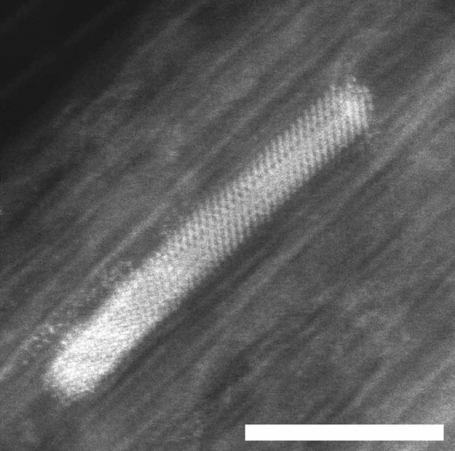
Electron micrograph of a Ni nanocrystal inside a single wall carbon nanotube; scale bar 5 nm.[12]
Nickel is a silvery-white metal with a slight golden tinge that takes a high polish.
It is one of only four elements that are magnetic at or near room temperature, the others being iron, cobalt and gadolinium. Its Curie temperature is 355 °C (671 °F), meaning that bulk nickel is non-magnetic above this temperature.[13] The unit cell of nickel is a face-centered cube with the lattice parameter of 0.352 nm, giving an atomic radius of 0.124 nm. This crystal structure is stable to pressures of at least 70 GPa. Nickel belongs to the transition metals. It is hard, malleable and ductile, and has a relatively high for transition metals electrical and thermal conductivity.[14] The high compressive strength of 34 GPa, predicted for ideal crystals, is never obtained in the real bulk material due to the formation and movement of dislocations; however, it has been reached in Ni nanoparticles.[15]
Electron configuration dispute
The nickel atom has two electron configurations, [Ar] 3d8 4s2 and [Ar] 3d9 4s1, which are very close in energy – the symbol [Ar] refers to the argon-like core structure. There is some disagreement on which configuration has the lowest energy.[16] Chemistry textbooks quote the electron configuration of nickel as [Ar] 4s2 3d8,[17]Inorganic%20Ch]]which can also be written [Ar] 3d8 4s2.[[18]](https://openlibrary.org/search?q=Petrucci%2C%20R.H.%20et%20al.%20%282002%29%20 [[CITE|18|https://openlibrary.org/search?q=Petrucci%2C%20R.H.%20et%20al.%20%282002%29%20General%20Chemistry%208) Madelung energy ordering rule]], which predicts that 4s is filled before 3d. It is supported by the experimental fact that the lowest energy state of the nickel atom is a 3d8 4s2 energy level, specifically the 3d8(3F) 4s2 3F, [19]
However, each of these two configurations splits into several energy levels due to fine structure,[19] and the two sets of energy levels overlap. The average energy of states with configuration [Ar] 3d9 4s1 is actually lower than the average energy of states with configuration [Ar] 3d8 4s2. For this reason, the research literature on atomic calculations quotes the ground state configuration of nickel as [Ar] 3d9 4s1.[16]
Isotopes
The isotopes of nickel range in atomic weight from 48 u (48Ni) to 78 u (78Ni).
Naturally occurring nickel is composed of five stable isotopes; 58Ni, 60Ni, 61Ni, 62Ni and 64Ni, with 58Ni being the most abundant (68.077% natural abundance). Isotopes heavier than 62Ni cannot be formed by nuclear fusion without losing energy.
Nickel-62 has the highest mean nuclear binding energy per nucleon of any nuclide, at 8.7946 MeV/nucleon.[20] Its binding energy is greater than both 56 Fe and 58 Fe, more abundant elements often incorrectly cited as having the most tightly-bound nuclides.[21] Although this would seem to predict nickel-62 as the most abundant heavy element in the universe, the relatively high rate of photodisintegration of nickel in stellar interiors causes iron to be by far the most abundant.[21]
Stable isotope nickel-60 is the daughter product of the extinct radionuclide 60 Fe, which decays with a half-life of 2.6 million years.
Because 60Fe has such a long half-life, its persistence in materials in the solar system may generate observable variations in the isotopic composition of 60Ni. Therefore, the abundance of 60Ni present in extraterrestrial material may provide insight into the origin of the solar system and its early history.
Some 18 nickel radioisotopes have been characterised, the most stable being 59Ni with a half-life of 76,000 years, 63Ni with 100 years, and 56Ni with 6 days. All of the remaining radioactive isotopes have half-lives that are less than 60 hours and the majority of these have half-lives that are less than 30 seconds. This element also has one meta state.[22]
Radioactive nickel-56 is produced by the silicon burning process and later set free in large quantities during type Ia supernovae. The shape of the light curve of these supernovae at intermediate to late-times corresponds to the decay via electron capture of nickel-56 to cobalt-56 and ultimately to iron-56.[23] Nickel-59 is a long-lived cosmogenic radionuclide with a half-life of 76,000 years. 59Ni has found many applications in isotope geology. 59Ni has been used to date the terrestrial age of meteorites and to determine abundances of extraterrestrial dust in ice and sediment. Nickel-78's half-life was recently measured at 110 milliseconds, and is believed an important isotope in supernova nucleosynthesis of elements heavier than iron.[24] The nuclide 48Ni, discovered in 1999, is the most proton-rich heavy element isotope known. With 28 protons and 20 neutrons 48Ni is "double magic", as is 78Ni with 28 protons and 50 neutrons. Both are therefore unusually stable for nuclides with so large a proton-neutron imbalance.[22][25]
Occurrence
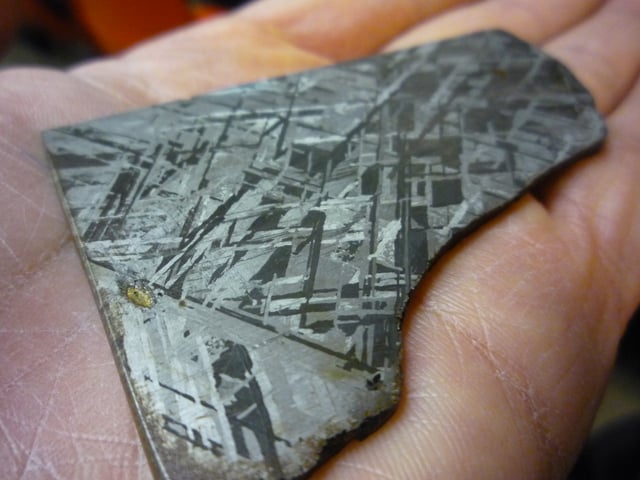
Widmanstätten pattern showing the two forms of nickel-iron, kamacite and taenite, in an octahedrite meteorite
The bulk of the nickel is mined from two types of ore deposits. The first is laterite, where the principal ore mineral mixtures are nickeliferous limonite, (Fe,Ni)O(OH), and garnierite (a mixture of various hydrous nickel and nickel-rich silicates). The second is magmatic sulfide deposits, where the principal ore mineral is pentlandite: (Ni,Fe)9S8.
Australia and New Caledonia have the biggest estimate reserves, at 45% of world's total.[27]
Identified land-based resources throughout the world averaging 1% nickel or greater comprise at least 130 million tons of nickel (about the double of known reserves).
About 60% is in laterites and 40% in sulfide deposits.[27]
On geophysical evidence, most of the nickel on Earth is believed to be in the Earth's outer and inner cores. Kamacite and taenite are naturally occurring alloys of iron and nickel. For kamacite, the alloy is usually in the proportion of 90:10 to 95:5, although impurities (such as cobalt or carbon) may be present, while for taenite the nickel content is between 20% and 65%. Kamacite and taenite are also found in nickel iron meteorites.[28]
Compounds

Tetracarbonyl nickel
The most common oxidation state of nickel is +2, but compounds of Ni0, Ni+, and Ni3+ are well known, and the exotic oxidation states Ni2−, Ni1−, and Ni4+ have been produced and studied.[29]
Nickel(0)
Nickel tetracarbonyl (Ni(CO)4), discovered by Ludwig Mond,[30] is a volatile, highly toxic liquid at room temperature. On heating, the complex decomposes back to nickel and carbon monoxide:
- ⇌ Ni + 4 CO
This behavior is exploited in the Mond process for purifying nickel, as described above. The related nickel(0) complex bis(cyclooctadiene)nickel(0) is a useful catalyst in organonickel chemistry because the cyclooctadiene (or cod) ligands are easily displaced.
Nickel(I)
Nickel(I) complexes are uncommon, but one example is the tetrahedral complex NiBr(PPh3)3.
Many nickel(I) complexes feature Ni-Ni bonding, such as the dark red diamagnetic K4[Ni2(CN)6] prepared by reduction of K2[Ni2(CN)6] with sodium amalgam. This compound is oxidised in water, liberating H2.[31]
It is thought that the nickel(I) oxidation state is important to nickel-containing enzymes, such as [NiFe]-hydrogenase, which catalyzes the reversible reduction of protons to H2.[32]
Nickel(II)

Color of various Ni(II) complexes in aqueous solution.
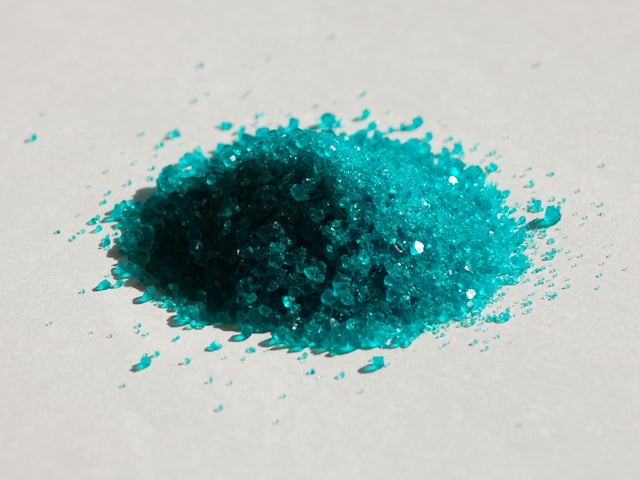
Crystals of hydrated nickel sulfate.
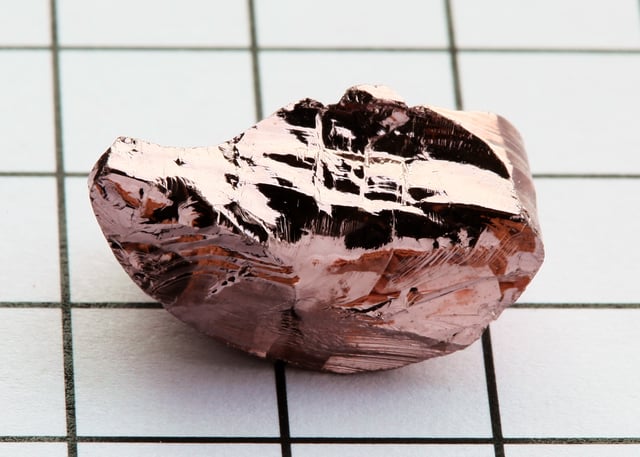
Nickel(III) antimonide
Nickel(II) forms compounds with all common anions, including sulfide, sulfate, carbonate, hydroxide, carboxylates, and halides. Nickel(II) sulfate is produced in large quantities by dissolving nickel metal or oxides in sulfuric acid, forming both a hexa- and heptahydrates[33] useful for electroplating nickel. Common salts of nickel, such as the chloride, nitrate, and sulfate, dissolve in water to give green solutions of the metal aquo complex [Ni(H2O)6]2+.
The four halides form nickel compounds, which are solids with molecules that feature octahedral Ni centres.
Nickel(II) chloride is most common, and its behavior is illustrative of the other halides. Nickel(II) chloride is produced by dissolving nickel or its oxide in hydrochloric acid. It is usually encountered as the green hexahydrate, the formula of which is usually written NiCl2•6H2O. When dissolved in water, this salt forms the metal aquo complex [Ni(H2O)6]2+. Dehydration of NiCl2•6H2O gives the yellow anhydrous NiCl2.
Some tetracoordinate nickel(II) complexes, e.g. bis(triphenylphosphine)nickel chloride, exist both in tetrahedral and square planar geometries. The tetrahedral complexes are paramagnetic, whereas the square planar complexes are diamagnetic. In having properties of magnetic equilibrium and formation of octahedral complexes, they contrast with the divalent complexes of the heavier group 10 metals, palladium(II) and platinum(II), which form only square-planar geometry.[29]
Nickelocene is known; it has an electron count of 20, making it relatively unstable.
Nickel(III) and (IV)
Ni(IV) is present in the mixed oxide BaNiO3, while Ni(III) is present in nickel oxide hydroxide, which is used as the cathode in many rechargeable batteries, including nickel-cadmium, nickel-iron, nickel hydrogen, and nickel-metal hydride, and used by certain manufacturers in Li-ion batteries.[36] Ni(IV) remains a rare oxidation state of nickel and very few compounds are known to date.[37][38][39][40]
History
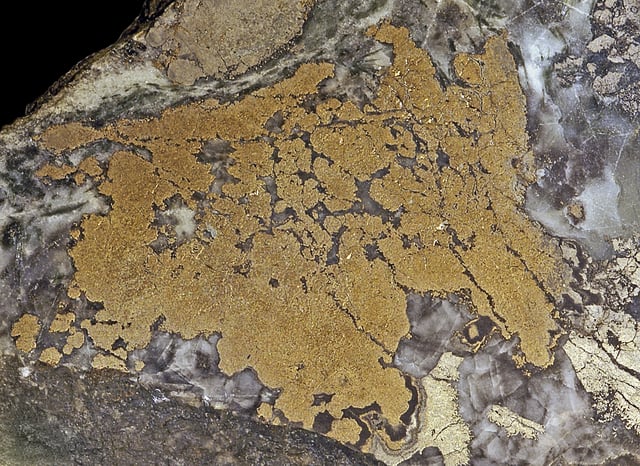
nickeline/niccolite
Because the ores of nickel are easily mistaken for ores of silver, understanding of this metal and its use dates to relatively recent times.
However, the unintentional use of nickel is ancient, and can be traced back as far as 3500 BCE.
Bronzes from what is now Syria have been found to contain as much as 2% nickel.[41] Some ancient Chinese manuscripts suggest that "white copper" (cupronickel, known as baitong) was used there between 1700 and 1400 BCE. This Paktong white copper was exported to Britain as early as the 17th century, but the nickel content of this alloy was not discovered until 1822.[42] Coins of nickel-copper alloy were minted by the Bactrian kings Agathocles, Euthydemus II and Pantaleon in the 2nd Century BCE, possibly out of the Chinese cupronickel.[43]
In medieval Germany, a red mineral was found in the Erzgebirge (Ore Mountains) that resembled copper ore. However, when miners were unable to extract any copper from it, they blamed a mischievous sprite of German mythology, Nickel (similar to Old Nick), for besetting the copper. They called this ore Kupfernickel from the German Kupfer for copper.[44][45][46][47] This ore is now known to be nickeline, a nickel arsenide. In 1751, Baron Axel Fredrik Cronstedt tried to extract copper from kupfernickel at a cobalt mine in the Swedish village of Los, and instead produced a white metal that he named after the spirit that had given its name to the mineral, nickel.[48] In modern German, Kupfernickel or Kupfer-Nickel designates the alloy cupronickel.[14]
Originally, the only source for nickel was the rare Kupfernickel.
Beginning in 1824, nickel was obtained as a byproduct of cobalt blue production. The first large-scale smelting of nickel began in Norway in 1848 from nickel-rich pyrrhotite. The introduction of nickel in steel production in 1889 increased the demand for nickel, and the nickel deposits of New Caledonia, discovered in 1865, provided most of the world's supply between 1875 and 1915. The discovery of the large deposits in the Sudbury Basin, Canada in 1883, in Norilsk-Talnakh, Russia in 1920, and in the Merensky Reef, South Africa in 1924, made large-scale production of nickel possible.[42]
Coinage
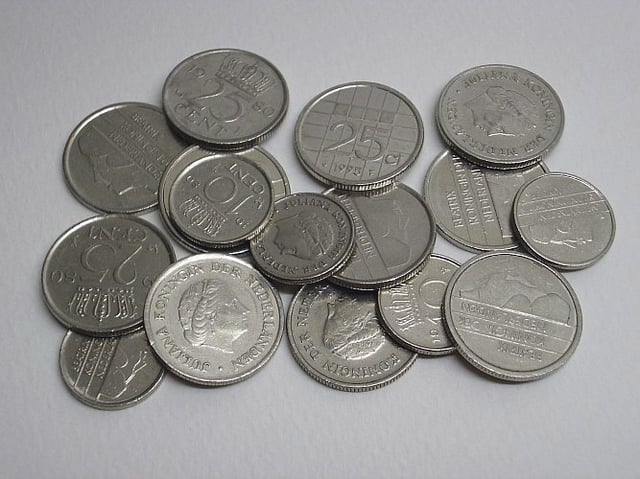
Dutch coins made of pure nickel
Aside from the aforementioned Bactrian coins, nickel was not a component of coins until the mid-19th century.
Canada
99.9% nickel five-cent coins were struck in Canada (the world's largest nickel producer at the time) during non-war years from 1922–1981; the metal content made these coins magnetic.[49] During the wartime period 1942–45, most or all nickel was removed from Canadian and US coins to save it for manufacturing armor.[45][50] Canada used 99.9% nickel from 1968 in its higher-value coins until 2000.
Switzerland
Coins of nearly pure nickel were first used in 1881 in Switzerland.[51]
United Kingdom
Birmingham forged nickel coins in about 1833 for trading in Malaya.[52]
United States
In the United States, the term "nickel" or "nick" originally applied to the copper-nickel Flying Eagle cent, which replaced copper with 12% nickel 1857–58, then the Indian Head cent of the same alloy from 1859–1864. Still later, in 1865, the term designated the three-cent nickel, with nickel increased to 25%. In 1866, the five-cent shield nickel (25% nickel, 75% copper) appropriated the designation. Along with the alloy proportion, this term has been used to the present in the United States.
Current use
In the 21st century, the high price of nickel has led to some replacement of the metal in coins around the world.
Coins still made with nickel alloys include one- and two-euro coins, 5¢, 10¢, 25¢ and 50¢ U.S. coins, and 20p, 50p, £1 and £2 UK coins. Nickel-alloy in 5p and 10p UK coins was replaced with nickel-plated steel began in 2012, causing allergy problems for some people and public controversy.[51]
World production

Time trend of nickel production[53]

Nickel ores grade evolution in some leading nickel producing countries.
More than 2.3 million tonnes (t) of nickel per year are mined worldwide, with Indonesia (560,000 t), The Philippines (340,000 t), Russia (210,000 t), New Caledonia (210,000 t), Australia (170,000 t) and Canada (160,000 t) being the largest producers as of 2019.[27] The largest deposits of nickel in non-Russian Europe are located in Finland and Greece. Identified land-based resources averaging 1% nickel or greater contain at least 130 million tonnes of nickel. Approximately 60% is in laterites and 40% is in sulfide deposits. In addition, extensive deep-sea resources of nickel are in manganese crusts and nodules covering large areas of the ocean floor, particularly in the Pacific Ocean.[54]
The one locality in the United States where nickel has been profitably mined is Riddle, Oregon, where several square miles of nickel-bearing garnierite surface deposits are located. The mine closed in 1987.[55][56] The Eagle mine project is a new nickel mine in Michigan's upper peninsula. Construction was completed in 2013, and operations began in the third quarter of 2014.[57] In the first full year of operation, Eagle Mine produced 18,000 t.[57]
Extraction and purification

Evolution of the annual nickel extraction, according to ores.
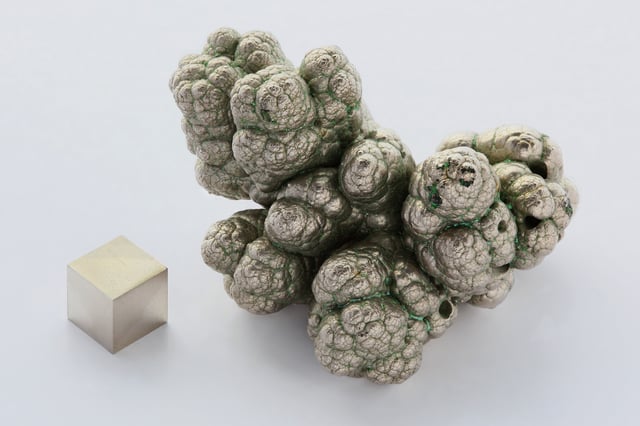
Electrolytically refined nickel nodule, with green, crystallized nickel-electrolyte salts visible in the pores.
Nickel is obtained through extractive metallurgy: it is extracted from the ore by conventional roasting and reduction processes that yield a metal of greater than 75% purity. In many stainless steel applications, 75% pure nickel can be used without further purification, depending on the impurities.
Traditionally, most sulfide ores have been processed using pyrometallurgical techniques to produce a matte for further refining. Recent advances in hydrometallurgical techniques resulted in significantly purer metallic nickel product. Most sulfide deposits have traditionally been processed by concentration through a froth flotation process followed by pyrometallurgical extraction. In hydrometallurgical processes, nickel sulfide ores are concentrated with flotation (differential flotation if Ni/Fe ratio is too low) and then smelted. The nickel matte is further processed with the Sherritt-Gordon process. First, copper is removed by adding hydrogen sulfide, leaving a concentrate of cobalt and nickel. Then, solvent extraction is used to separate the cobalt and nickel, with the final nickel content greater than 99%.
Electrorefining
A second common refining process is leaching the metal matte into a nickel salt solution, followed by the electro-winning of the nickel from solution by plating it onto a cathode as electrolytic nickel.
Mond process
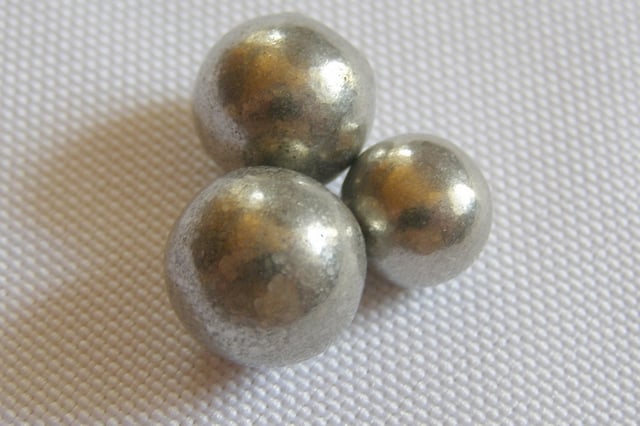
Highly purified nickel spheres made by the Mond process.
The purest metal is obtained from nickel oxide by the Mond process, which achieves a purity of greater than 99.99%.[58] The process was patented by Ludwig Mond and has been in industrial use since before the beginning of the 20th century. In this process, nickel is reacted with carbon monoxide in the presence of a sulfur catalyst at around 40–80 °C to form nickel carbonyl. Iron gives iron pentacarbonyl, too, but this reaction is slow. If necessary, the nickel may be separated by distillation. Dicobalt octacarbonyl is also formed in nickel distillation as a by-product, but it decomposes to tetracobalt dodecacarbonyl at the reaction temperature to give a non-volatile solid.[59]
Nickel is obtained from nickel carbonyl by one of two processes.
It may be passed through a large chamber at high temperatures in which tens of thousands of nickel spheres, called pellets, are constantly stirred.
The carbonyl decomposes and deposits pure nickel onto the nickel spheres.
In the alternate process, nickel carbonyl is decomposed in a smaller chamber at 230 °C to create a fine nickel powder.
The byproduct carbon monoxide is recirculated and reused.
The highly pure nickel product is known as "carbonyl nickel".[60]
Metal value
The US nickel coin contains 0.04 ounces (1.1 g) of nickel, which at the April 2007 price was worth 6.5 cents, along with 3.75 grams of copper worth about 3 cents, with a total metal value of more than 9 cents. Since the face value of a nickel is 5 cents, this made it an attractive target for melting by people wanting to sell the metals at a profit. However, the United States Mint, in anticipation of this practice, implemented new interim rules on December 14, 2006, subject to public comment for 30 days, which criminalized the melting and export of cents and nickels.[63] Violators can be punished with a fine of up to $10,000 and/or imprisoned for a maximum of five years.
As of September 19, 2013, the melt value of a US nickel (copper and nickel included) is $0.045, which is 90% of the face value.[64]
Applications
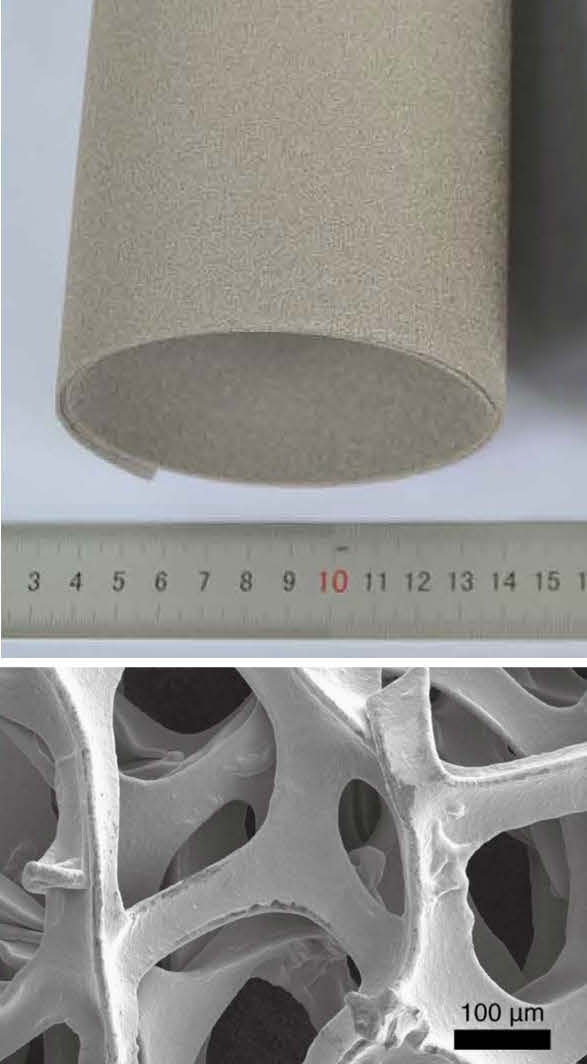
Nickel foam (top) and its internal structure (bottom)

A "horseshoe magnet" made of alnico nickel alloy.
Nickel is used in many specific and recognizable industrial and consumer products, including stainless steel, alnico magnets, coinage, rechargeable batteries, electric guitar strings, microphone capsules, plating on plumbing fixtures,[65] and special alloys such as permalloy, elinvar, and invar. It is used for plating and as a green tint in glass. Nickel is preeminently an alloy metal, and its chief use is in nickel steels and nickel cast irons, in which it typically increases the tensile strength, toughness, and elastic limit. It is widely used in many other alloys, including nickel brasses and bronzes and alloys with copper, chromium, aluminium, lead, cobalt, silver, and gold (Inconel, Incoloy, Monel, Nimonic).[66]
Because it is resistant to corrosion, nickel was occasionally used as a substitute for decorative silver.
Nickel was also occasionally used in some countries after 1859 as a cheap coinage metal (see above), but in the later years of the 20th century was replaced by cheaper stainless steel (i.e., iron) alloys, except in the United States and Canada.
Nickel is an excellent alloying agent for certain precious metals and is used in the fire assay as a collector of platinum group elements (PGE). As such, nickel is capable of fully collecting all six PGE elements from ores, and of partially collecting gold. High-throughput nickel mines may also engage in PGE recovery (primarily platinum and palladium); examples are Norilsk in Russia and the Sudbury Basin in Canada.
Nickel and its alloys are frequently used as catalysts for hydrogenation reactions. Raney nickel, a finely divided nickel-aluminium alloy, is one common form, though related catalysts are also used, including Raney-type catalysts.
Nickel is a naturally magnetostrictive material, meaning that, in the presence of a magnetic field, the material undergoes a small change in length.[69][70] The magnetostriction of nickel is on the order of 50 ppm and is negative, indicating that it contracts.
Nickel is used as a binder in the cemented tungsten carbide or hardmetal industry and used in proportions of 6% to 12% by weight. Nickel makes the tungsten carbide magnetic and adds corrosion-resistance to the cemented parts, although the hardness is less than those with a cobalt binder.[71]
63Ni, with its half-life of 100.1 years, is useful in krytron devices as a beta particle (high-speed electron) emitter to make ionization by the keep-alive electrode more reliable.[72]
Around 27% of all nickel production is destined for engineering, 10% for building and construction, 14% for tubular products, 20% for metal goods, 14% for transport, 11% for electronic goods, and 5% for other uses.[10]
Biological role
Raney nickel is widely used for hydrogenation of unsaturated oils to make margarine, and substandard margerine and leftover oil may contain nickel as contaminant. Forte et al. found that type 2 diabetic patients have 0.89 ng/ml of Ni in the blood relative to 0.77 ng/ml in the control subjects.[73] Although not recognized until the 1970s, nickel is known to play an important role in the biology of some plants, eubacteria, archaebacteria, and fungi.[74][75][76] Nickel enzymes such as urease are considered virulence factors in some organisms.[77][78] Urease catalyzes the hydrolysis of urea to form ammonia and carbamate.[75][74] The NiFe hydrogenases can catalyze the oxidation of H2 to form protons and electrons, and can also catalyze the reverse reaction, the reduction of protons to form hydrogen gas.[75][74] A nickel-tetrapyrrole coenzyme, cofactor F430, is present in methyl coenzyme M reductase, which can catalyze the formation of methane, or the reverse reaction, in methanogenic archaea.[79] One of the carbon monoxide dehydrogenase enzymes consists of an Fe-Ni-S cluster.[80] Other nickel-bearing enzymes include a rare bacterial class of superoxide dismutase[81] and glyoxalase I enzymes in bacteria and several parasitic eukaryotic trypanosomal parasites[82] (in higher organisms, including yeast and mammals, this enzyme contains divalent Zn2+).[83][84][85][86][87]
Dietary nickel may affect human health through infections by nickel-dependent bacteria, but it is also possible that nickel is an essential nutrient for bacteria residing in the large intestine, in effect functioning as a prebiotic.[88] The US Institute of Medicine has not confirmed that nickel is an essential nutrient for humans, so neither a Recommended Dietary Allowance (RDA) nor an Adequate Intake have been established. The Tolerable Upper Intake Level of dietary nickel is 1000 µg/day as soluble nickel salts. Dietary intake is estimated at 70 to 100 µg/day, with less than 10% absorbed. What is absorbed is excreted in urine.[89] Relatively large amounts of nickel – comparable to the estimated average ingestion above – leach into food cooked in stainless steel. For example, the amount of nickel leached after 10 cooking cycles into one serving of tomato sauce averages 88 µg.[90][91]
Nickel released from Siberian Traps volcanic eruptions is suspected of assisting the growth of Methanosarcina, a genus of euryarchaeote archaea that produced methane during the Permian–Triassic extinction event, the biggest extinction event on record.[92]
Toxicity
The major source of nickel exposure is oral consumption, as nickel is essential to plants.[94] Nickel is found naturally in both food and water, and may be increased by human pollution. For example, nickel-plated faucets may contaminate water and soil; mining and smelting may dump nickel into waste-water; nickel–steel alloy cookware and nickel-pigmented dishes may release nickel into food. The atmosphere may be polluted by nickel ore refining and fossil fuel combustion. Humans may absorb nickel directly from tobacco smoke and skin contact with jewelry, shampoos, detergents, and coins. A less-common form of chronic exposure is through hemodialysis as traces of nickel ions may be absorbed into the plasma from the chelating action of albumin.
The average daily exposure does not pose a threat to human health.
Most of the nickel absorbed every day by humans is removed by the kidneys and passed out of the body through urine or is eliminated through the gastrointestinal tract without being absorbed.
Nickel is not a cumulative poison, but larger doses or chronic inhalation exposure may be toxic, even carcinogenic, and constitute an occupational hazard.[95]
Nickel compounds are classified as human carcinogens[96][97][98][99] based on increased respiratory cancer risks observed in epidemiological studies of sulfidic ore refinery workers.[100] This is supported by the positive results of the NTP bioassays with Ni sub-sulfide and Ni oxide in rats and mice.[101][102] The human and animal data consistently indicate a lack of carcinogenicity via the oral route of exposure and limit the carcinogenicity of nickel compounds to respiratory tumours after inhalation.[103][104] Nickel metal is classified as a suspect carcinogen;[96][97][98] there is consistency between the absence of increased respiratory cancer risks in workers predominantly exposed to metallic nickel[100] and the lack of respiratory tumours in a rat lifetime inhalation carcinogenicity study with nickel metal powder.[105] In the rodent inhalation studies with various nickel compounds and nickel metal, increased lung inflammations with and without bronchial lymph node hyperplasia or fibrosis were observed.[99][101][105][106] In rat studies, oral ingestion of water-soluble nickel salts can trigger perinatal mortality effects in pregnant animals.[107] Whether these effects are relevant to humans is unclear as epidemiological studies of highly exposed female workers have not shown adverse developmental toxicity effects.[108][109][110][111]
People can be exposed to nickel in the workplace by inhalation, ingestion, and contact with skin or eye.
The Occupational Safety and Health Administration (OSHA) has set the legal limit (permissible exposure limit) for the workplace at 1 mg/m3 per 8-hour workday, excluding nickel carbonyl. The National Institute for Occupational Safety and Health (NIOSH) specifies the recommended exposure limit (REL) of 0.015 mg/m3 per 8-hour workday. At 10 mg/m3, nickel is immediately dangerous to life and health.[112] Nickel carbonyl [Ni(CO)4] is an extremely toxic gas. The toxicity of metal carbonyls is a function of both the toxicity of the metal and the off-gassing of carbon monoxide from the carbonyl functional groups; nickel carbonyl is also explosive in air.[113][114]
Sensitized individuals may show a skin contact allergy to nickel known as a contact dermatitis. Highly sensitized individuals may also react to foods with high nickel content.[115] Sensitivity to nickel may also be present in patients with pompholyx. Nickel is the top confirmed contact allergen worldwide, partly due to its use in jewelry for pierced ears.[116] Nickel allergies affecting pierced ears are often marked by itchy, red skin. Many earrings are now made without nickel or low-release nickel[117] to address this problem. The amount allowed in products that contact human skin is now regulated by the European Union. In 2002, researchers found that the nickel released by 1 and 2 Euro coins was far in excess of those standards. This is believed to be the result of a galvanic reaction.[118] Nickel was voted Allergen of the Year in 2008 by the American Contact Dermatitis Society.[119] In August 2015, the American Academy of Dermatology adopted a position statement on the safety of nickel: "Estimates suggest that contact dermatitis, which includes nickel sensitization, accounts for approximately $1.918 billion and affects nearly 72.29 million people."[115]
Reports show that both the nickel-induced activation of hypoxia-inducible factor (HIF-1) and the up-regulation of hypoxia-inducible genes are caused by depletion of intracellular ascorbate. The addition of ascorbate to the culture medium increased the intracellular ascorbate level and reversed both the metal-induced stabilization of HIF-1- and HIF-1α-dependent gene expression.[120][121]